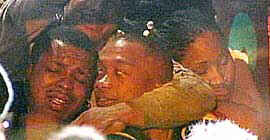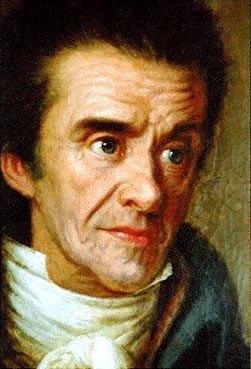| ^
1997 CompuServe chief resigns
CompuServe chief Robert Massey tendered his resignation, ending his brief, but tumultuous run at the helm of the company. After a successful stint as the head of CompuServe’s network service division, Massey was tabbed to take control of the entire company in late 1995. However, his tenure atop CompuServe was plagued by fiscal woes and failed business decisions, as the company, which was making a heated push in the burgeoning online services field, ultimately wilted under the furious competition of its rival service provider, America Online (AOL). The key moment in Massey’s brief reign was his decision to launch an aggressive marketing campaign designed to help CompuServe control the online service market. Though the campaign initially lured a batch of new subscribers, it couldn’t stave off the competition and eventually helped cripple the company’s bottom line. In 1996, CompuServe went public with an initial offering price of $35.50 a share; by the time of Massey’s resignation, the stock had plummeted to a paltry $10.8125. And, to add insult to injury, CompuServe’s subscription base began to dwindle, prompting the company to withdraw from the rough-and-tumble world of online services and instead focus on its more profitable business services work. |
 ^
1996 Kasparov defeats Deep
Blue . . . this time ^
1996 Kasparov defeats Deep
Blue . . . this time In Philadelphia world chess champion Garry Kasparov and Deep Blue conclude their first best of six-games match. Kasparov had easily defeated Deep Blue’s predecessor — Deep Thought — in 1994, but Deep Blue would prove to be one of the most difficult opponents in the world champion’s career. On 10 February 1996, in Game 1, Deep Blue made history by defeating a visibly frustrated Kasparov. Deep Blue’s victory was the first time that a current world champion had ever been beaten by a computer opponent under regular tournament conditions. But Kasparov would not go down so easily. The world champion, known for his tenacity and his ferocious will to win, used his signature ability to switch strategies mid-game to take Game 2 on 11 February. Game 3 (13 Feb) and Game 4 (14 Feb), although tightly contested, ended up in draws. Then, on 16 February, in Game 5, Kasparov again changed tactics mid-game to defeat Deep Blue. He needs no more than a draw in game six to win the match. Deep Blue, playing the Black pieces, comes out swinging after a Slav defense opening in Game 6, but Kasparov expertly fends off the computer’s belligerent attacks. Kasparov wins this final game and takes the match by a score of 4 - 2. Citing the match as one of the most difficult of his career, Kasparov issues a rematch challenge for 1997, and IBM's Deep Blue team immediately accepts on Deep Blue's behalf. Kasparov would lose the rematch, ending on 11 May 1997. It would be the first time that he ever loses a six-game match in championship play The game: 1. Nf3 d5 2. d4 c6 3. c4 e6 4. Nbd2 Nf6 5. e3 c5 6. b3 Nc6 7. Bb2 cxd4 8. exd4 Be7 9. Rc1 O-O 10. Bd3 Bd7 11. O-O Nh5 12. Re1 Nf4 13. Bb1 Bd6 14. g3 Ng6 15. Ne5 Rc8 16. Nxd7 Qxd7 17. Nf3 Bb4 18. Re3 Rfd8 19. h4 Nge7 20. a3 Ba5 21. b4 Bc7 22. c5 Rde8 23. Qd3 g6 24. Re2 Nf5 25. Bc3 h5 26. b5 Nce7 27. Bd2 Kg7 28. a4 Ra8 29. a5 a6 30. b6 Bb8 31. Bc2 Nc6 32. Ba4 Re7 33. Bc3 Ne5 34. dxe5 Qxa4 35. Nd4 Nxd4 36. Qxd4 Qd7 37. Bd2 Re8 38. Bg5 Rc8 39. Bf6+ Kh7 40. c6 bxc6 41. Qc5 Kh6 42. Rb2 Qb7 43. Rb4. Black resigns. |
1995 Colin Ferguson ias convicted of six counts of murder for the December 1993 Long Island Rail Road shootings. He would be sentenced to a minimum of 200 years in prison.
| ^
1993 La canción Els Segadors es aprobada
como himno de Catalunya Els Segadors es una canción popular del siglo XVII que habla de la guerra de los catalanes contra el rey Felipe IV y su valido, el conde-duque de Olivares, que se vieron ayudados por los payeses. Este enfrentamiento desarrollado en los años 1639 y 1640 incorporó a los símbolos nacionalistas las imágenes de campesinos enarbolando sus herramientas de trabajo. Unas imágenes que explícitamente se mantienen en la letra del actual himno oficial de Cataluña. . Aunque en la letra más antigua incluso se afirmaba que «de la sang dels castellans en farem tinta vermella», la letra actual es de finales del siglo XIX y durante los regímenes dictatoriales del siglo XX (de los generales Primo de Rivera y Franco) estuvo prohibida. El Departament de Ensenyament de la Generalitat dispuso que Els Segadors se enseñe a los alumnos de primaria a partir del curso 2001~2002. |
||
| Catalunya, triomfant, Tornarà a ser rica i plena! Endarrera aquesta gent Tan ufana i tan superba! Bon cop de falç! Bon cop de falç, defensors de la terra! Bon cop de falç! |
Ara és hora, segadors! Ara és hora d’estar alerta! Per quan vingui un altre juny Esmolem ben bé les eines! Bon cop de falç! Bon cop de falç, defensors de la terra! Bon cop de falç! |
Que tremoli l’enemic en veient la nostra ensenya: com fem caure espigues d’or, quan convé seguem cadenes! Bon cop de falç! Bon cop de falç, defensors de la terra! Bon cop de falç! |
1989 Concluye la segunda cumbre magrebí en Marrakech, con un pacto defensivo y el nacimiento de la Unión del Magreb Árabe.
1989 6-week study of Arctic atmosphere shows no ozone "hole"
1986 Libyan bombers attack N'djamena Airport in Chad.
1986 Técnicos de la compañía de aviación española Iberia descubren sabotajes en sus aviones.
| ^
1986 The Accidental Tourist wins award
Anne Tyler wins the National Book Critics Circle Award for her novel The Accidental Tourist (1985). The book, about the life of a travel-book writer after the death of his son and his subsequent divorce, became a bestseller and was later made into a movie starring William Hurt. Tyler was born in Minneapolis in 1941, the oldest of four children born to a chemist and a social worker. The family lived in Quaker communes in rural areas until Tyler was 11 and the family moved to Raleigh, North Carolina. She had never used a telephone by the time the family left the commune, but she was an avid reader. She entered Duke University at age 16 and majored in Russian while also experimenting with creative writing. She worked as a university librarian and bibliographer, then married an Iranian child psychiatrist in 1963. Tyler published her first novel, If Morning Ever Comes, in 1964 and published several more over the next few years while raising two daughters. Her 1975 novel, Waiting for Caleb, about five generations of a Baltimore family, won national praise, but it wasn't until 1982 that she broke through as a bestselling novelist, with Dinner at the Homesick Restaurant. Her 1988 novel, Breathing Lessons, exploring three decades of a marriage, won the 1989 Pulitzer Prize. |

 1827
1827